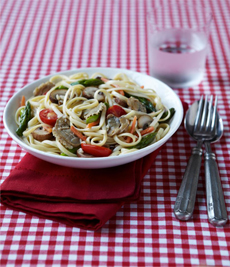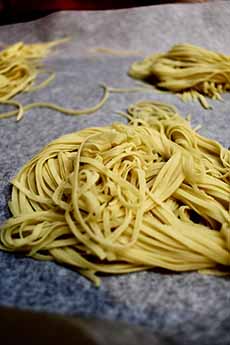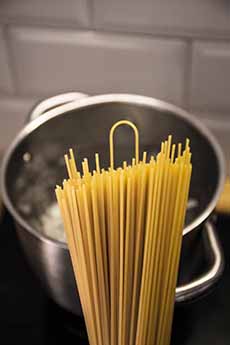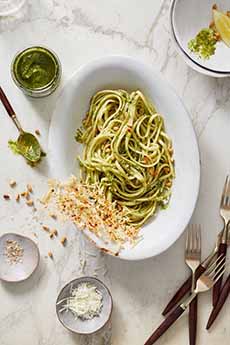RECIPE: Linguine Alla Vongole, With Clam Sauce & Asparagus
 [1] Linguine and clam sauce with asparagus. The recipe is below (photo © Dole).
|
Before asparagus season ends, get your fill by adding it to your favorite dishes. Here’s an example of how easy it is, courtesy of Dole, which adds its fresh asparagus to the classic pasta dish, linguine with clam sauce. Consider using whole wheat linguine for fiber and flavor. If asparagus season has passed, add green beans or snow peas. This recipe makes 4 servings; prep time 10 minutes; cook time 25 minutes. Speaking of linguine (lin-GWEE-nay)…Americans often misspell it linguini. Show you’re a food connoisseur and use the original Italian! Originating in the Liguria, the costal region of northern Italy (capital Genoa), linguine is a narrow, flat version of round spaghetti (it is sometimes referred to as flat spaghetti). It’s a narrower version of another popular flat ribbon pasta, fettuccine. September 15th is National Linguine Day. > The history of linguine is below. > Check out the different types of pasta in our Pasta Glossary. If asparagus is out of season, use broccoli florets. Ingredients 1. BRING a large pot of water to a boil. Cook linguine according to manufacturer’s instructions. Meanwhile… 2. HEAT the oil in a large nonstick skillet over medium-high heat. Add the mushrooms, garlic, salt and pepper. Cook for 5 minutes until mushrooms begin to brown. 3. ADD the asparagus, carrots and two tablespoons of water. Toss to combine and cover skillet. Cook 4 minutes longer. 4. ADD the tomatoes and the clam juice. Cook uncovered 1 minute longer. If the pasta is not yet cooked, remove vegetables and clams from heat and cook pasta until it is al dente. 5. DRAIN pasta and add to the vegetable mixture along with the reserved clams. Raise heat to high and cook 2-3 minutes longer until pasta is thoroughly coated and most of the liquid is absorbed. 6. PLATE and serve. Do you know the difference between popular pasta cuts and shapes? Linguine is a flat ribbon, a narrower version of fettuccine (or, fettuccine is wider linguine. Spaghetti is a round ribbon pasta, thin like linguine. Bucatini is a thick round ribbon with a hole in the center (like a sipping straw). There are hundreds of pasta shapes in Italy—estimates range from 350 to as many as 600. Some are very similar, but with different names because they originated in different regions, in the days before mass communications could get the word out. |
|
|
THE HISTORY OF LINGUINE Linguini, a flat ribbon pasta that is wider than spaghetti but narrower than fettuccine, appears to have originated in 1700s in the region of Liguria, in northwestern Italy. Giulio Giacchero, author of a book on the economy of Genoa at that time, writes about trenette (another name for linguini) served with pesto, green beans and potatoes*. He notes that trenette al pesto was a typical festive dish of Ligurian families of the time [source]. It was served for special occasions, and as a Sunday dish, until the mid-20th century, when it became part of the everyday repertoire [source]. Both linguine and trenette are narrow, flat, and long, trenette just a smidge wider and elliptical in cross section rather than flat. Often, the terms are used interchangeably. Why does one region have two almost identical pastas with different names? As a coastal region, Ligurians had plenty of seafood to mix with their pasta. Hence, the popularity of linguine alla vongole (VAWN-go-lay), linguine in clam sauce and linguine misto mare, linguine with mixed seafood (mussels, scallops, shrimp, squid tentacles). Since basil pesto (pesto alla Genovese) also originated in Liguria (a major basil-growing region), pasta with pesto sauce was, and is, also very popular. By the last century, linguine had spread throughout Italy. And yes, red sauce lovers: Linguine is also popularly served with arrabbiata and marinara sauces. *Pasta with potatoes? Strange? No. Remember that the days before refrigeration, meals had to be made from foods that were in season, or could be stored into the next season. CHECK OUT WHAT’S HAPPENING ON OUR HOME PAGE, THENIBBLE.COM. |
||





